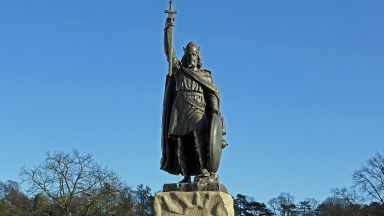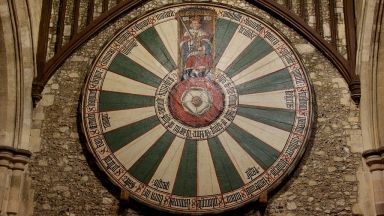King Alfred Statue, Winchester
Statue in Winchester

Commissioned by Alderman Bowker and the City Corporation, the magnificent bronze statue created by Hamo Thornycroft commemorates the millennium of Aelfred’s death. Erected in 1901, this larger-than-life sculpture stands 15 feet (4.57 m) tall and weighs 5 tons, being 2.5 times the size of an average person. Its striking presence is enhanced by the two-part base made of Cornish Granite, resulting in a total height of 40 feet.
The statue portrays Aelfred with a cross-hilted sword grasped in his right hand, symbolizing Christianity’s fight against heathenism. The left foot confidently strides forward, displaying a gesture of kingship and the subjugation of enemies. A Saxon helmet adorns the head, while the left hand rests gently on a Saxon circular shield. The cloak, draped over the right shoulder, serves as both protection for the king and an invitation for viewers to walk around the statue and admire it from various angles. The granite pedestal bears a simple inscription: “AELFRED.”
Aelfred, born in Wantage, Berkshire, was the fifth child of Ethelwulf, King of Wessex, and Queen Osburgh. Influenced by his parents’ emphasis on learning and religion, Aelfred spent his early years in their court. His father, educated at the Old Minster in Winchester under Bishop Swithun, had a significant impact on his upbringing. Records indicate that Aelfred embarked on two pilgrimages to Rome, one at the age of four and another alongside his father two years after Queen Osburgh’s death.
Upon Ethelwulf’s return to a divided kingdom, Aelfred left the rule of Wessex and Kent to his elder brothers and focused on strengthening his own position. Aelfred married Ealhswith, the granddaughter of the King of Mercia, and granted her an estate in Winchester, where the Nunnaminster was later constructed. Aelfred faced numerous challenges, including Danish invasions, which led to negotiations and temporary peace agreements, known as Danegelt, where he paid the Danes to avoid conflict.
Aelfred used the time gained from these agreements to fortify his kingdom and develop a formidable naval fleet. He employed mercenaries initially but later constructed his own superior fleet of ships to counter the Danish invaders. While facing setbacks and further negotiations, Aelfred’s resilience and determination prevailed. He engaged in guerilla warfare, rallying supporters and launching surprise attacks on the Danes. In a decisive battle at Eddington, Aelfred defeated Guthrum, the Danish leader, and laid siege to their camp, leading to Guthrum’s surrender.
As part of the agreement, England was divided, with Guthrum ruling in East Anglia and Aelfred maintaining control over Wessex. Remarkably, Guthrum later embraced Christianity and lived peacefully until his death. Aelfred’s naval achievements continued, with his ships defeating Danish raiders along the south coast. The captured Danish crews were hanged in Winchester as a deterrent.
During the remaining years of his reign, Aelfred implemented numerous reforms and enjoyed a relatively peaceful period. His legacy as a great ruler and reformer continues to inspire admiration and respect.
The King Alfred Statue, Winchester appears in our Complete Guide to Visiting Winchester!
This website uses affiliate links which may earn a commission at no additional cost to you!
Visiting King Alfred Statue, Winchester
24Hours
Free
Nearby Attractions
- St Mary's Abbey, Winchester (0.0) km
Abbey in Winchester - Winchester Guildhall (0.1) km
Historic Building and Tourist Office in Winchester - Winchester City Mill (0.1) km
Mill in Winchester - City Walls of Winchester (0.1) km
City Walls in Winchester - The Chesil Rectory (0.2) km
Historic Building in Winchester - St Peter's Church, Chesil, Winchester (0.2) km
Church and Theatre in Winchester - St Mary Magdalen Hospital Alms-houses (0.2) km
Historic Building in Winchester - Wolvesey Castle (0.3) km
Palace in Winchester - Winchester Cathedral (0.3) km
Cathedral in Winchester - Winchester Cathedral Close (0.3) km
Historic Site in Winchester

